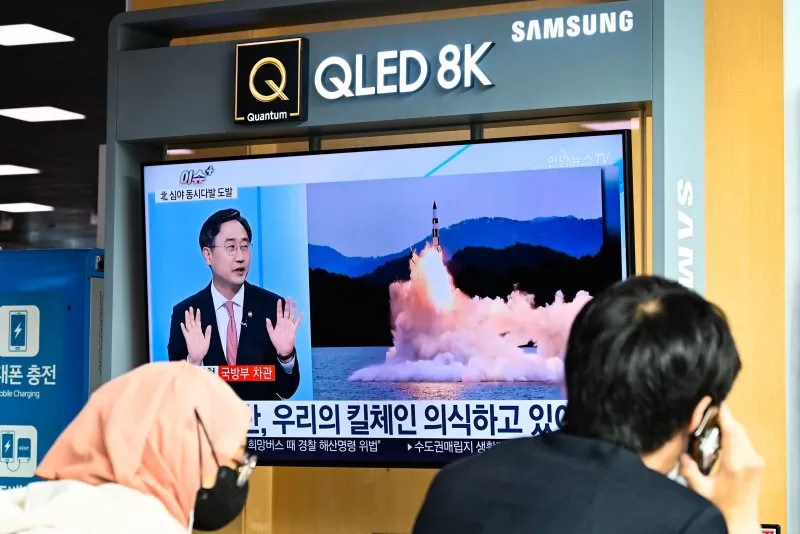North Korea launched a long-range missile believed to be its newest and most powerful ICBM Thursday, South Korean and Japanese defense officials said. File Photo by Thomas Maresca/UPI
SEOUL, Oct. 31 (UPI) — North Korea launched what appears to be its newest and most powerful intercontinental ballistic missile on Thursday, South Korean and Japanese defense officials said, a provocation coming just days ahead of the U.S. presidential election.
South Korea’s military detected a long-range missile fired from the Pyongyang area into the sea between Korea and Japan at 7:10 a.m., the Joint Chiefs of Staff said in a text message to reporters.
The missile was launched at a sharply lofted angle and flew approximately 620 miles, the JCS said.
“So far, the initial judgment is that it may have been a test launch of a new solid-propellant long-range ballistic missile,” Defense Ministry spokesman Lee Kyung-ho said at a later press briefing.
Missiles using solid-fuel propellants can be transported and launched more quickly than liquid-fuel models.
The test had been anticipated by South Korean defense officials. Seoul’s Defense Intelligence Agency told lawmakers Wednesday that North Korea was preparing for a possible ICBM launch ahead of the U.S. presidential election on Nov. 5. It added the North has also completed internal preparations for a nuclear test at its Punggye-ri site.
Japan’s Defense Ministry also reported the launch, saying that the missile flew for 86 minutes — the longest flight time ever for a North Korean missile — and reached a maximum altitude of over 4,500 miles.
It splashed down in the sea west of Okushiri Island in Hokkaido, outside of Japan’s exclusive economic zone, the ministry said.
“We estimate that the ballistic missile launched this time had the longest flight time and the highest flight altitude to date, and we are still analyzing the details, including whether it was a new type of ballistic missile,” Japanese Defense Minister Gen Nakatani told reporters, according to broadcaster NHK.
North Korea’s last ICBM launch was in December 2023. That missile, the nuclear-capable solid-fuel Hwasong-18, traveled for 73 minutes and is believed capable of reaching anywhere in the continental United States.
The White House “strongly” condemned Thursday’s test, calling it a “flagrant” violation of multiple U.N. Security Council resolutions.
“While U.S. [Indo-Pacific Command] has assessed it did not pose an immediate threat to U.S. personnel, or territory, or to our allies, this launch needlessly raises tensions and risks destabilizing the security situation in the region,” National Security Council spokesman Sean Savett said in a statement.
“It only demonstrates that the DPRK continues to prioritize its unlawful weapons of mass destruction and ballistic missile programs over the well-being of its people,” Savett said, using the official acronym for North Korea.
The missile test comes as North Korea has dispatched troops to Russia to assist Moscow’s war against Ukraine. Hours before the launch, U.S and South Korean defense chiefs condemned the cooperation “in the strongest terms with a unified voice.”
U.S. Defense Secretary Lloyd Austin and South Korean Defense Minister Kim Yong-hyun made the joint statement during their annual Security Consultative Meeting talks at the Pentagon Wednesday.
Washington has said that the North has sent around 10,000 troops to eastern Russia, with some already nearing Ukraine.
“Some of those troops have begun to make their way towards the border of Ukraine in the Kursk region,” Austin said during a press conference.
“Whether or not they’ll be employed in the fight is left to be seen yet,” Austin said. “But certainly, if they are employed, then that’s very disturbing.”
Kim, meanwhile, warned that the cooperation would escalate security threats on the Korean Peninsula and could lead to greater nuclear and missile capabilities for the North.
“There is a high possibility that North Korea, in exchange for their troop deployment, would ask for cutting-edge technology transfer,” Kim said. “North Korea is very likely to ask for technology transfers in diverse areas, including the technologies relating to tactical nuclear weapons technologies [and] related to their advancement of ICBMs.”
Kim added that the North could hope to “exaggerate their existence” during the U.S. presidential election season with provocations such as an ICBM launch or the country’s seventh nuclear test.

